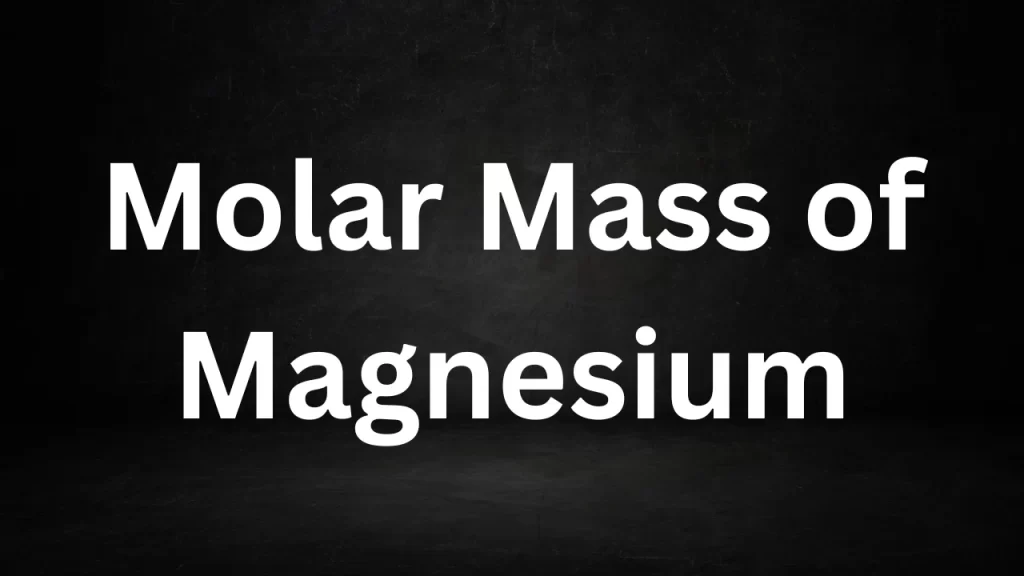Tag: mgso4 7h2o massa molar
Molar Mass Of Magnesium
Molar Mass Of Magnesium: Magnesium, a versatile and essential element, holds a significant place in the periodic table.
Its role in various natural processes, industrial applications, and biological systems makes it a subject of great interest in the world of chemistry. In this article, we’ll explore the concept of the molar mass of magnesium, understand its significance, and uncover the atomic weight of this mighty element.

Molar Mass Of Magnesium
Understanding Molar Mass
Before we delve into the specifics of magnesium, let’s establish what molar mass signifies. Molar mass, often referred to as molecular weight or atomic weight, is a fundamental concept in chemistry. It represents the mass of a substance in grams per mole (g/mol) and is expressed in unified atomic mass units (u) or atomic mass units (amu).
The molar mass is calculated by summing the atomic masses of all the atoms in a chemical compound, considering their respective proportions. It serves as a bridge between the microscopic world of atoms and molecules and the macroscopic world of measurable quantities in chemistry.
The Atomic Structure of Magnesium
Magnesium, with the atomic symbol Mg and atomic number 12, is a light, silvery-white, and highly abundant element in the Earth’s crust. It falls within Group 2 (Group IIA) on the periodic table, a category recognized as the alkaline earth metals. Magnesium’s atomic configuration exhibits the following features:
Atomic Number: 12 (indicating the number of protons in the nucleus)
- Atomic Mass: Approximately 24.31 atomic mass units (u)
- Electron Configuration: [Ne] 3s² (indicating its electron arrangement)
- Number of Electrons: 12 (equal to the number of protons in a neutral atom)
Calculating the Molar Mass of Magnesium
The mol mass of magnesium is determined by summing the atomic mass of a single magnesium atom. Since magnesium exists as individual atoms in its elemental form (Mg), the mol mass is equal to its atomic mass. The atomic mass of magnesium is approximately 24.31 u.
Therefore, the mol mass of magnesium (Mg) is approximately 24.31 g/mol. This numerical value finds application in diverse chemical calculations, including the determination of magnesium quantities in a given sample and assessing the composition of chemical compounds containing magnesium atoms.
Significance of the Molar Mass of Magnesium
The mol mass of magnesium is of great importance in several domains:
1. Chemical Reactions: In stoichiometry, the molar mass plays a vital role in determining the quantities of reactants and products involved in chemical reactions. It enables chemists to balance chemical equations and calculate the mass of substances consumed or produced.
2. Laboratory Analysis: When conducting experiments involving magnesium, scientists and researchers need to know its molar mass to make precise measurements and ensure accurate results.
3. Industrial Applications: Industries that utilize magnesium and its compounds, such as the automotive and aerospace sectors, rely on the molar mass for quality control and product development.
4. Environmental Studies: Environmental scientists use the molar mass of magnesium to analyze soil composition, study groundwater chemistry, and assess the impact of magnesium-containing substances on ecosystems.
5. Dietary Considerations: Magnesium is an essential mineral in the human diet, and its molar mass is relevant for nutritional assessments and dietary recommendations.
Conclusion: Magnesium’s Atomic Weight Unveiled
In conclusion, the molar mass of magnesium, approximately 24.31 g/mol, is a fundamental parameter in chemistry. It represents the atomic weight of this versatile element, empowering scientists, researchers, and industries to explore its diverse applications. Beyond the lab, magnesium’s importance extends to advancing science, technology, and enhancing our comprehension of the natural world.
Read More
- Law Of Conservation Of Energy
- Difference Between Equinox And Solstice
- Molecular Weight Of K2Cr2O7
- Molecular Weight Of Phosphorus
- Molecular Weight Of SO2
Frequently Asked Questions (FAQs) Molar Mass Of Magnesium
1. What is the molar mass of magnesium?
The mol mass of magnesium (Mg) is approximately 24.31 grams per mole (g/mol).
2. How is the mol mass of magnesium calculated?
The mol mass of magnesium is calculated by summing the atomic mass of a single magnesium atom. In the case of magnesium, the atomic mass is approximately 24.31 atomic mass units (u), which is equivalent to 24.31 g/mol.
3. Why is the mol mass of magnesium important in chemistry?
Magnesium’s molar mass is vital for chemical calculations like stoichiometry, aiding in balancing equations and precisely measuring reactants and products.
4. Is the mol mass of magnesium used in industries and manufacturing processes?
Yes, industries that utilize magnesium or magnesium-containing compounds rely on the mol mass for quality control, product development, and ensuring the proper composition of materials.
5. How does the mol mass of magnesium impact environmental studies?
Environmental scientists use the mol mass of magnesium to analyze soil composition, assess groundwater chemistry, and study the environmental impact of magnesium-containing substances.